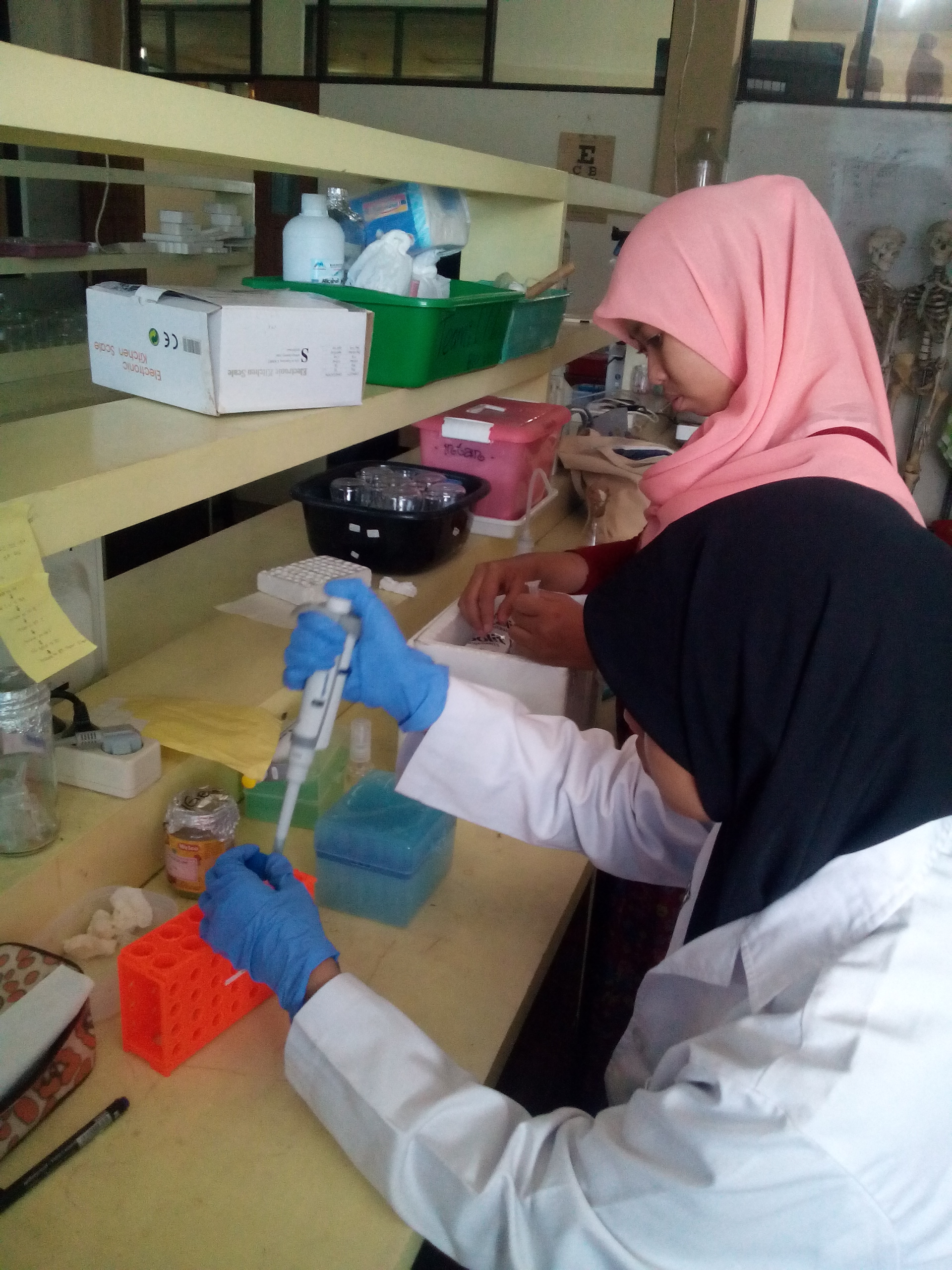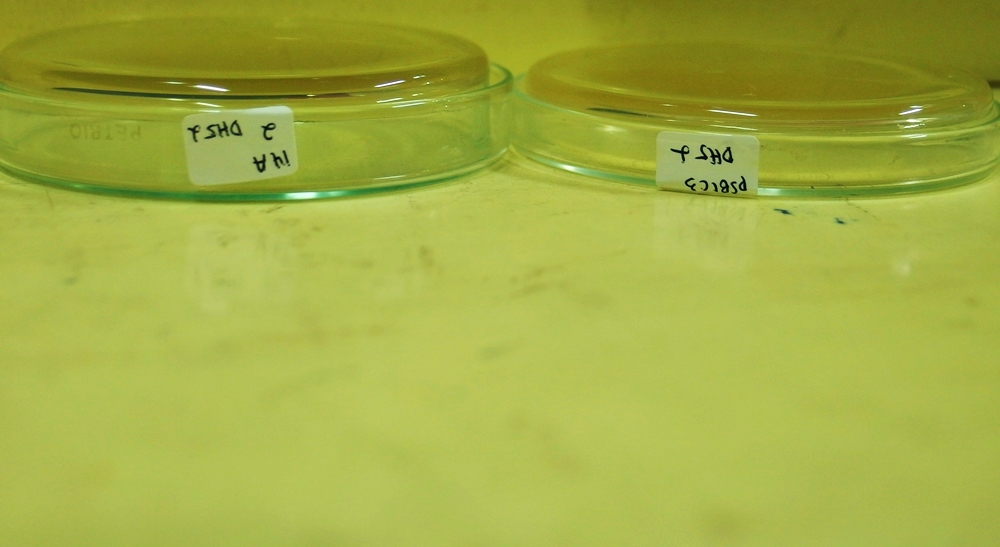Team:UB Indonesia
From 2014.igem.org
(Difference between revisions)
| Line 354: | Line 354: | ||
<p align="justify"> | <p align="justify"> | ||
<b>Overview Therapy</b><br> | <b>Overview Therapy</b><br> | ||
| - | CHS (Cancer Herbal Screening) part is design plasmid which contain promoter P97 (HPV 16) or P105 (HPV 18). This part has ability in screening chemical compounds of plant for cervical cancer therapy. The herbs have to inhibit transcription factor of P97 and P10. Promoter was combained with fluorescence reporter GFP obtained from biobrick Bba_E0240 (Plate 4, well 11N) to detect the successfull of the herbal compounds. P97 (HPV 16) and P105(HPV 18) were digested with EcoR1-Xbal, GFP digested with Xbal- | + | Cervical cancer is the one of most killing cause of woman. Approximately, 300.000 people deaths by cervical cancer in every year (Frazer, Cox et al., 2006; Lowy and Schiller, 2006).Cervical cancer caused by Human papillomaviruses (HPV) (Martinez et al., 2008).More than 100 types of HPVs have been identified to date (Dell et al., 2001), but the two most common types in cervical cancer are HPV 16 and 18. HPV type 16 and 18 are high risk type that causecervical cancer (Das, 2003). Both of those type responsible for approximately 70 % of all cases (Smith et al., 2007).<br><br> |
| - | <center><img src="https://static.igem.org/mediawiki/2014/ | + | |
| + | HPV are small double-stranded DNA viruses that contain of two oncogenes E6 and E7 that are involved in cellular transformation. Two viral genes, E6 and E7 are commonly found expressed in these cancer cells (Song, 2000). Transcription of the human papillomavirus type 16 (HPV-16) genome is controlled by several promoters and the P97 promoter is considered to be the main one (Braunstein et al., 1999). P97 is the HPV-16 early promoter involved in the transcription of E6, E7 and other viral genes (Dell and Gaston, 2011; Flores and Lambert, 1997; Hebner and Laimins, 2006. Based on Laura et al (2005), P105 is located to the next E6 start codon and is the main early promoter of HPV-18. AP-1, Sp-1, NF-1, Oct-1, TEF-1, YY-1, KRF-1, Skn-1a, and TFIID known as transcription factors that could stimulate P105 promoter activity. HPV-18 P105 promoter and HPV-16 P97 promoter has equivalent function. E2 repression of P105 promoter activity has been demonstrated in HeLa cells (Thierry and Yaniv, 1987) and in primary human keratinocytes (Bernard et al., 1989). Romanczuk et al(1990), suggested that P97 and P105 promoters both could be regulated by similar mechanisms. A comparison of the sequences upstream of the HPV-16 P97 promoter and the HPV-18 P105 promoter revealed a similar spatial arrangement of the four E2-binding sites, the TATAAAA boxes, and the start sites for transcription in the respective viral LCRs. (Romanczuk et al, 1990). Based on Chong et al(1991), trancript factor such as NF1, AP-1, and oct-1 were present in higher concentration in HeLa cells. Therefor, HeLa cells can be used as transfection for promoter P97 and promoter P105 so it could be activated.<br><br> | ||
| + | |||
| + | Indonesia has many potential herb that potentially used as medicine for cervical cancer. The major goal ofthis research is to create a kit that can screen herb potentially used as medicine for cervical cancer. It can give early information for researcher, doctor and other practical that can be used as reference to continue the research as well as to give scientific. CHS (Cancer Herbal Screening) part is design plasmid which contain promoter P97 (HPV 16) or P105 (HPV 18). This part has ability in screening chemical compounds of plant for cervical cancer therapy. The herbs have to inhibit transcription factor of P97 and P10. <br><br> | ||
| + | |||
| + | Promoter was combained with fluorescence reporter GFP obtained from biobrick Bba_E0240 (Plate 4, well 11N) to detect the successfull of the herbal compounds. P97 (HPV 16) and P105 (HPV 18) were digested with EcoR1-Xbal, GFP digested with Xbal-Pstl, and plasmid backbone pSB1C3 digested with EcoR1-Pstl. Then, the HPV promoter and GFP was ligated into palsmid backbone pSB1C3. Plasmid design was transfected into HeLa cells containing some transcripton factor to induced promoter. Based on Chong et al (1991), trancript factor such as NF1, AP-1, and oct-1 were present in higher concentration in HeLa cells. Therefor, HeLa cells can be used as transfection for promoter P97 and promoter P105 so it could be activated. This part was purposed to help researcher work easier to explore herbal plants for cervical cancer therapy.</p> <br><br> | ||
| + | |||
| + | <center><img src="https://static.igem.org/mediawiki/2014/e/ef/UB-overview_therapy.PNG" width="500" height="300"><br> | ||
| + | Figure 1. Construction of CHS (Cancer Herbal Screening) in pSB1C3 | ||
| + | </center> | ||
| + | |||
| + | <p align="justify"> | ||
| + | <b>References :</b><br> | ||
| + | <ul> | ||
| + | <li>Bernard, B. A., C. Bailly, M.-C. Lenoir, M. Darmon, F. Thierry, and M. Yaniv. 1989. The human papillomavirus type 18 (HPV18) E2 gene product is a repressor of the HPV18 regulatory region in human keratinocytes. J. Virol 63:4317-4324.</li> | ||
| + | <li>Braunstein TH, BS Madsen, B Gavnholt, MW Rosenstierne, C Koefoed Johnsen and B norrild. 1999. Identification of a new promoter in the early region of the human papillomaviruses type 16 genome. Journal of General Virology 80: 3241-3250</li> | ||
| + | <li>Chong, T., D. Apt, B. Gloss, M. Isa, and H. U. Bernard. 1991. The enhancer of human papillomavirus type 16: binding sites for the ubiquitous transcription factors Oct-1, NFA, TEF-2, NF1, and AP1 participate in epithelial cell-specific transcription. J. Virol. 65:5933–5943. </li> | ||
| + | <li>Das, B.C. 2003. Cellular control of human papillomavirus gene activity in cervical cancer. Proc.Indian natn Sci Acan. B69 No.1 pp23-24. </li> | ||
| + | <li>Dell, G., and K. Gaston. 2001. Contributions in the domain of cancer research:review of human papillomaviruses and their role in cervical cancer.Cell. Mol. Life Sci.58:1923–1942. </li> | ||
| + | <li>Flores, E. R., and P. F. Lambert. 1997. Evidence for a switch in the mode of human papillomavirus type 16 DNA replication during the viral life cycle. J. Virol. 71:7167–7179. </li> | ||
| + | <li>Frazer, I. H., J. T. Cox, et al. 2006. Advances in prevention of cervical cancer and other human papillomavirus-related diseases.Pediatr Infect Dis J 25(2 Suppl): S65-81, quiz S82. </li> | ||
| + | <li>Hebner, C. M., and L. A. Laimins. 2006. Human papillomaviruses: basic mechanisms of pathogenesis and oncogenicity. Rev. Med. Virol16:83–97. </li> | ||
| + | <li>Laura Sichero, Eduardo Luis Franco, and Luisa Lina Villa. 2005. Different P105 Promoter Activities among Natural Variants of Human Papillomavirus Type 18. The Journal of Infectious Diseases191:739–42. </li> | ||
| + | <li>Lowy, D. R. and J. T. Schiller. 2006. Prophylactic human papillomavirus vaccines. J Clin Invest 116(5): 1167-73. </li> | ||
| + | <li>Martinez., AS Gardiner, KF Board, FA Monzon, RP Edwards and SA Khan. 2008. Human papillomavirus type 16 reduces the expression of microRNA-218 in cervical carcinoma cells. Oncogene 27:2575-2582</li> | ||
| + | <li>Romanczuk H., F Thierry and P M Howley. 1990.Mutational analysis of cis elements involved in E2 modulation of human papillomavirus type 16 P97 and type 18 P105 promoters. J. Virol64(6):2849. </li> | ||
| + | <li>Smith JS, Lindsay L, Hoots B, Keys J, Franceschi S, Winer R, et al. 2007. Human papillomavirus type distribution in invasive cervical cancer and high-grade cervical lesions: a meta-analysis update. International journal of cancer121:621-32. </li> | ||
| + | <li>Song, Shiyu., Amy Liem, James A., Miller and Paul F Lambert. 2000. Human Papillomavirus Types 16 E6 and E7 Contribute Differently to Carcinogenesis. Virology 267:141-150. </li> | ||
| + | <li>Thierry, F., and M. Yaniv. 1987. The BPV1-E2 trans-acting protein can be either an activator or a repressor of the HPV 18 regulatory region. EMBO J6:3391-3397. </li> | ||
| + | <li>Thierry, F., J. M. Heard, K. Dartmann, and M. Yaniv. 1987. Characterization of a transcriptional promoter of human papillomavirus 18 and modulation of its expression by simian virus 40 and adenovirus early antigens. J. Virol61:134-142. </li> | ||
| + | </ul> | ||
</p> | </p> | ||
</div> | </div> | ||
| Line 458: | Line 488: | ||
<ul> | <ul> | ||
<li>Week 1</li> | <li>Week 1</li> | ||
| - | Splitting HeLa cells. The confluence HeLa cells (80 – 90%) splitting into another flask then incubate in 37ᵒC. | + | Splitting HeLa cells. The confluence HeLa cells (80 – 90%) splitting into another flask then incubate in 37ᵒC.<br> |
| + | <center>https://static.igem.org/mediawiki/2014/0/0f/UB-HELA.jpg</center> | ||
<li>Week 2</li> | <li>Week 2</li> | ||
Cell observation. The splitting HeLa cells observed to control the growth. | Cell observation. The splitting HeLa cells observed to control the growth. | ||
| Line 945: | Line 976: | ||
<a href="#fav-parts" class="fancybox"><p><i class="icon icon-group"></i></p></a> | <a href="#fav-parts" class="fancybox"><p><i class="icon icon-group"></i></p></a> | ||
<div id="fav-parts" style="display:none;width:700px;"> | <div id="fav-parts" style="display:none;width:700px;"> | ||
| - | <h2><center> | + | <h2><center>Favorite Parts</center></h2><br> |
| - | < | + | <a href="http://parts.igem.org/Part:BBa_E0240:Design"><b>Bba_E0240 GFP_Generator </b></a><br> |
| + | <center> | ||
| + | <img src="https://static.igem.org/mediawiki/2014/0/0b/UB-GFP_1.PNG" width="200" height="300"> | ||
| + | <img src="https://static.igem.org/mediawiki/2014/d/d9/UB-GFP-PLASMID_2.PNG" width="500" height="500"></center><br><br> | ||
| + | |||
| + | <a href="http://parts.igem.org/Part:BBa_K747012"><b>Bba_K747012 TALE_Protein_TA1_Direpeat </b></a><br> | ||
| + | <center><img src="https://static.igem.org/mediawiki/2014/9/9b/UB-TALE-PLASMID_2.PNG" width="500" height="500"></center> | ||
</div> | </div> | ||
<h2 class="font-thin"><font color="#fff">Favorite Parts</font></h2> | <h2 class="font-thin"><font color="#fff">Favorite Parts</font></h2> | ||
Revision as of 16:44, 17 October 2014
 "
"























































